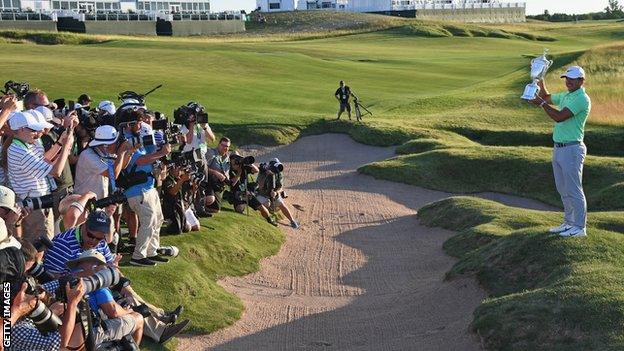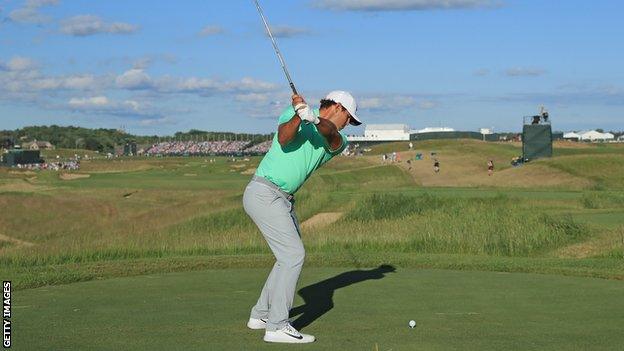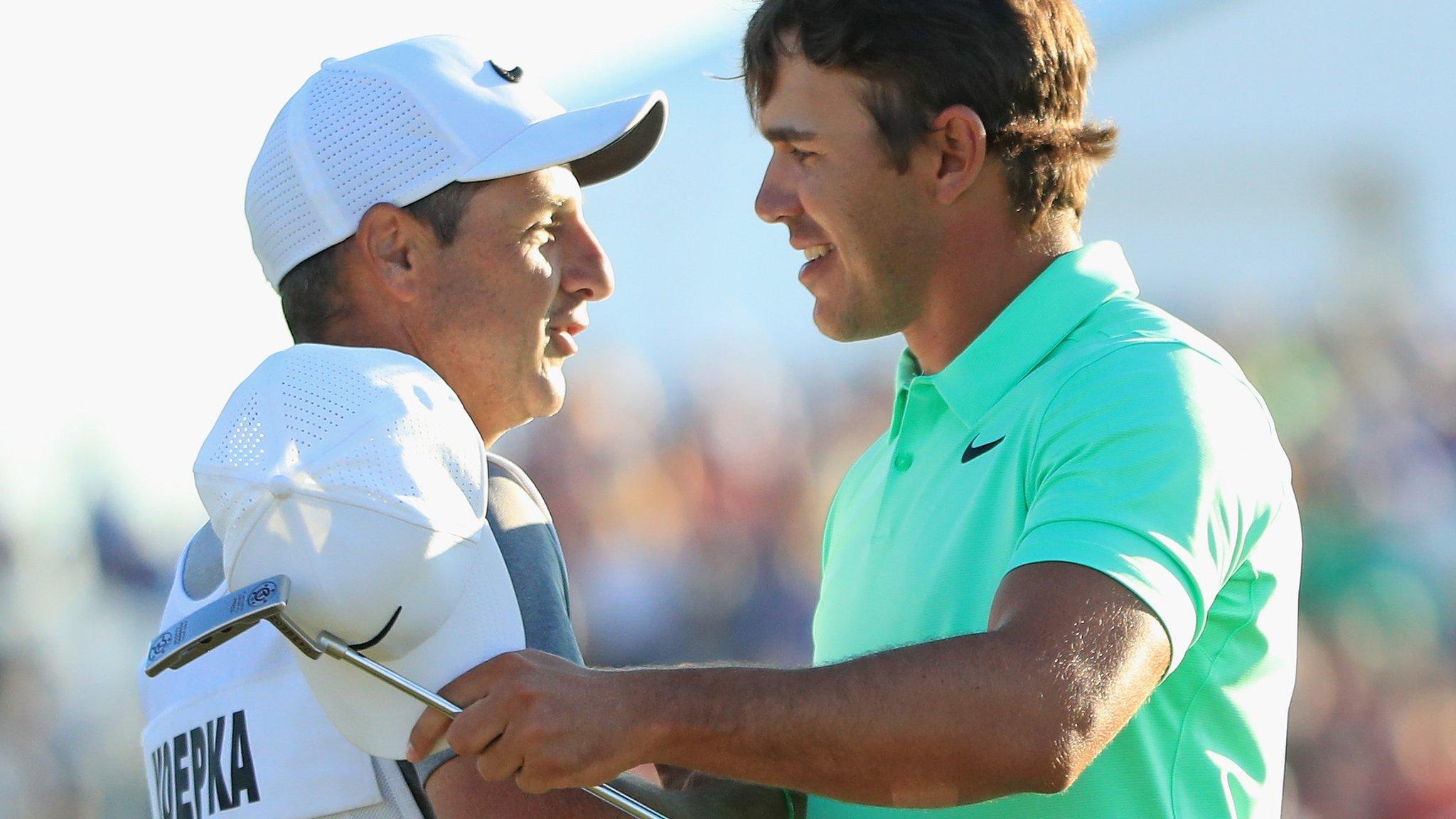US Open 2017: Subtlety of shot-making is being lost in professional golf
- Published
- comments

Brooks Koepka is now the seventh successive 'big-hitter' to have won a major championship.
If proof were needed that the golf ball is travelling too far, it was provided during Brooks Koepka's US Open triumph at Erin Hills.
This low-scoring slugfest was a freakish championship, played at a new and unique venue.
It would be wrong to draw too many conclusions, but the facts surrounding the distance issue are irrefutable.
The Wisconsin course was designed to be played firm and fast but conditions dictated the layout was soft and slow.
After tempestuous US Opens at Chambers Bay and Oakmont, organisers were under pressure to deliver a tournament free from controversy.
So the USGA erred on the side of caution to ensure its prime event did not suffer any further loss of credibility.
With strong winds sweeping the course on the final day the USGA, quite rightly, slowed the greens to ensure they remained playable.
All of these factors, and especially the pristine putting surfaces, ensured low scoring. Koepka's 16-under-par tally equalled Rory McIlroy's 2011 record at a rain-soaked Congressional.
On that occasion the Northern Irishman won by eight strokes - no-one else came close to taming the Maryland venue in such a manner. Twenty players broke par six years ago; this time the top 31 were in red figures.
Of course, the fact Erin Hills was rated par 72 skews the figures (Congressional was par 71) but the scoring on a 7,800-yard course emphatically shows that distance is no longer a barrier in the modern professional game.

Brooks Koepka won his first major championship at his fifth attempt
On the final tee on Sunday, Koepka knew he was on the threshold of his maiden major title.
With a subsiding wind at his back, he tackled the 681-yard par-five with a three wood and promptly dispatched it 379 yards.
In that last round, 50 of the 68 players to make the cut averaged more than 300 yards off the tee.
Professional golfers are, for the most part, gym-honed athletes trained to make the most of the powerful and generous sweet-spots that are the hallmark of modern golf clubs.
This takes nothing away from the undoubted skill they possess in channelling that power. Koepka is the perfect example because it was not just his length from the tee but his accuracy that provided the platform for his win.
"I drove the ball really well this week, so that really helps," the champion said.
"Obviously the fairways were a little bit wider and to have that where some of the misses typically would be in a bunker or deep rough, like a typical US Open."
The Floridian champion averaged 322 yards with his drives, the seventh longest, but hit 88% of fairways (fourth) throughout the week. That is a major-winning combination on a course characterised by length both in terms of yardage and rough.
Koepka made the most of the generous fairway widths as he became the seventh successive first-time major champion.
This run stretches back to Zach Johnson's Open triumph at St Andrews in 2015. The American winner at the Old Course is a rarity in not being known for his prowess from the tee.
Subsequent major winners Jason Day (PGA), Danny Willett (Masters), Dustin Johnson (US Open), Henrik Stenson (Open), Jimmy Walker (PGA) and Sergio Garcia (Masters) are all powerful, long hitters.

Golf Channel's Brandel Chamblee.
Koepka continues the trend, and now pundits such as the Golf Channel's Brandel Chamblee are advocating courses that break the 8,000-yard barrier.
It is an ill-affordable nightmare scenario. Layouts would need more land, more resources for maintenance and more time to play.
The emphasis is all on power and the subtlety of shot-making and shaping is being lost.
Amazingly, the authorities insist the golf ball is not travelling any further. They claim to have put the brakes on technology, but the evidence of last week - and most other professional tournaments - tells a different story.
Something needs to be done to rein back the ball to ensure courses remain relevant and the sport becomes more nuanced.
In the mid-90s, tennis realised it had a problem because fans were being put off because there were too few rallies at tournaments such as Wimbledon.
What did they do? They slowed down the ball and transformed the sport.
It was their ball and they had control. In golf it does not work that way because manufacturers hold sway.
The time is long overdue for the rules-makers to assume proper control. The R&A and USGA have to come up with a blueprint for a tournament ball appropriate to whichever course is being used that week.
Dictate the specifications and limits to the manufacturers and let them come up with the best ball they can.
The emphasis would shift from raw length to feel and playability while we amateurs could still use balls that give us the sort of distance that makes the game more enjoyable for us.
It might be possible to build monster courses such as Erin Hills in the wide open spaces of Wisconsin to accommodate the power of the modern game but it is inconceivable for golf's future to be based on such exceptional sites.
It is time to act.
- Published14 June 2017

- Published19 June 2017

- Published18 June 2017

- Published15 June 2017
